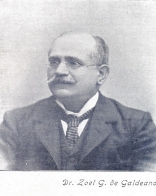Zoel García de Galdeano
Zoel García de Galdeano y Yanguas (born July 5, 1846 in Pamplona , † March 28, 1924 in Saragossa ) was a Spanish mathematician .
Life
Since his father, who was an officer, died in the war, he was raised by his grandfather, the historian José Yanguas y Miranda (1782–1863). He graduated from the University of Saragossa in 1871 with a degree in philosophy, literature and natural sciences, where he became an assistant professor of analysis, and received his doctorate soon afterwards. In 1872 he founded the Instituto Libre de Calahorra in Saragossa with other professors . He spent some time in the Ministry of the Interior in Madrid, but found he did not like administrative work and taught mathematics at high schools in Ciudad Real , Almería and Toledo before becoming Professor of Analytical Geometry at the University of Zaragoza in 1889. In 1896 he became professor of analysis and in 1918 he retired. Then he was an honorary professor at the university.
From 1916 to 1922 he was the first president of the Royal Academy of Sciences of Zaragoza, which he initiated in 1914 with José Rius . In 1916 he became President of the Spanish Mathematical Society founded in 1911. He was a member of the Royal Spanish Academy of Sciences. He was also the founder of the Asociación Española para el Progreso de las Ciencias in 1908, at whose congresses he regularly took part.
García de Galdeano played a key role in opening up Spain to modern mathematics at the end of the 19th and beginning of the 20th century (set theory by Georg Cantor , algebraic geometry, non-Euclidean geometry, Felix Klein's geometry concept based on the Erlangen program, strict analysis according to Karl Weierstraß , complex function theory, Lebesgue integral), established international relationships and had important students such as Julio Rey Pastor . Other important Spanish mathematicians in the early stages of modern mathematics in Spain were Leonardo Torres Quevedo , José Rius y Casas (1867–1940), Luis Octavio de Toledo y Zulueta (1857–1934) and, from the 19th century, the military engineer Antonio Torner Carbó ( 1825-1883). In 1901 he founded the magazine Revista Trimestral de Matemáticas with Quevedo and Rius , which existed until 1906.
He published mathematical textbooks and a total of around 200 scientific papers and was the founder and editor of the journal El Progreso Matemático in 1891 , the first specialist journal for mathematics in Spain. It was published from 1891 to 1895 and from 1899 to 1900.
He was invited speaker at the International Congress of Mathematicians (ICM) in Zurich in 1897 , in Paris in 1900 and in Rome in 1908 , but took part in all ICMs up to 1920 as well as in international congresses for mathematics education and mathematical bibliography as well as those of the Association Française pour l´Avancement des Sciences. From 1899 he was in the International Commission for Mathematical Bibliography (headed by Henri Poincaré ).
Fonts (selection)
- El álgebra históricamente y críticamente considerada, 1879
- Tratado de álgebra, 2 volumes, Madrid 1883, 1886
- Geometría elemental, 2 volumes, 1888
- Crítica y síntesis del álgebra, Toledo 1888
- Estudios críticos sobre la generación de los conceptos matemáticos, Madrid 1890
- Geometría general, Saragossa 1892 to 1895
- Teoremas, problemas y métodos geométricos, Saragossa 1892
- Sistematización de la geometría, Saragossa 1895
- Nueva Enciclopedia matemática, Saragossa 1904
- Tratado de análisis matemático, Saragossa: Emilio Casañal, 1904.
- Teoría de las ecuaciones diferenciales, Saragossa: E. Casañal, 1906.
- Tratado de análisis, in: Nueva Enciclopedia
- Exposición sumaria de las teorías matemáticas 1907
- Nuevo método de enseñanza matemática, Saragossa 1911
literature
- R. Rodriguez Vidal: Homenaje a la memoria de D. Zoel García de Galdeano, Gaceta Matemática, Volume 16, 1964, pp. 3-7
Web links
Individual evidence
- ^ For the first time in Spain in his Tratado de Análisis Matemático from 1904
- ^ For the first time in Spain in his geometry textbooks from 1888 and 1895
| personal data | |
|---|---|
| SURNAME | Galdeano, Zoel García de |
| BRIEF DESCRIPTION | Spanish mathematician |
| DATE OF BIRTH | July 5, 1846 |
| PLACE OF BIRTH | Pamplona |
| DATE OF DEATH | March 28, 1924 |
| Place of death | Zaragoza |
